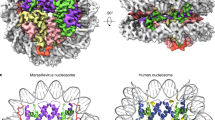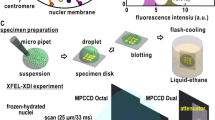Abstract
HISTONES and DNA make up the bulk of the chromosomal material and are presumably present in approximately a 1:1 ratio. Although it is known that histone fractions elicit specific antibodies1; a crude basic nuclear protein will bind to chromosomes2; antisera against lysine-rich histones will stain nuclei3; and purified histone antisera will bind to chromatin4, little is known about the distribution of histones in fixed preparations of chromosomes. We used the immuno-fluorescent technique to show that an antiserum prepared from the F3 histone fraction of human leukaemic lympho-blasts binds to both human and Drosophita salivary gland chromosomes5. We have now made antisera against the five major histone fractions of calf thymus and characterised them by microcomplement fixation6. Using selected antisera, we found that all except the F1 histone antiserum bind to acid-fixed Chinese hamster chromosomes to various degrees. Furthermore, in some preparations a pattern of transverse banding appears. We have also found that histones remaining on the chromosome after acid fixation are very firmly bound, which is necessary for the credibility of our observations.
This is a preview of subscription content, access via your institution
Access options
Subscribe to this journal
Receive 51 print issues and online access
$199.00 per year
only $3.90 per issue
Buy this article
- Purchase on Springer Link
- Instant access to full article PDF
Prices may be subject to local taxes which are calculated during checkout
Similar content being viewed by others
References
Stollar, B. D., and Ward, M., J. biol. Chem., 245, 1261–1266 (1970).
David, L. A., and Corey, M. J., Can. J. Genet. Cytol., 12, 570–581 (1970).
Hekman, A., and Sluyser, M., Biochim. Biophys. Acta, 295, 613–620 (1973).
Bustin, M., Nature, 245, 207–209 (1973).
Desai, S., Pothier, L., Foley, G. E., and Adams, R. A., Expl Cell Res., 70, 468–471 (1972).
Wasserman, E., and Levine, L., J. Immum., 87, 290–295 (1960).
Johns, E. W., Biochem. J., 92, 55–59 (1964).
Johns, E. W., Biochem.J., 105, 611–614 (1967).
Johns, E. W., Blochem. J., 104, 78–82 (1967).
Dick, C., and Johns, E. W., Expl Cell Res., 51, 626–632 (1968).
Brody, T., Expl Cell Res., 85, 255–263 (1974).
Comings, D. E., and Avelino, E., Expl Cell Res., 86, 202–206 (1974).
Stein, G. S., Hunter, G., and Lavie, L., Biochem. J., 139, 71–76 (1974).
Murray, K., J. molec. Biol., 15, 409–419 (1966).
Author information
Authors and Affiliations
Rights and permissions
About this article
Cite this article
POTHIER, L., GALLAGHER, J., WRIGHT, C. et al. Histones in fixed cytological preparations of Chinese hamster chromosomes demonstrated by immunofluorescence. Nature 255, 350–352 (1975). https://doi.org/10.1038/255350a0
Received:
Accepted:
Issue Date:
DOI: https://doi.org/10.1038/255350a0
This article is cited by
-
The presence of an antigen reactive with a human autoantibody inTrichosia pubescens (Diptera: Sciaridae) and its association with certain transcriptionally active regions of the genome
Chromosoma (1990)
-
The involvement of nucleosomes in Giemsa staining of chromosomes
Histochemistry (1985)
-
Immunofluorescent characterization of DNA�RNA hybrids on polytene chromosomes of Trichosia pubescens (Diptera, Sciaridae)
Chromosoma (1982)
-
Immunoelectronmicroscopy of metaphase chromosomes
Histochemistry (1982)
-
Effects of acetic acid-alcohol, trypsin, histone 1 and histone fragments on Giemsa staining patterns in chromosomes
Histochemistry (1980)
Comments
By submitting a comment you agree to abide by our Terms and Community Guidelines. If you find something abusive or that does not comply with our terms or guidelines please flag it as inappropriate.



